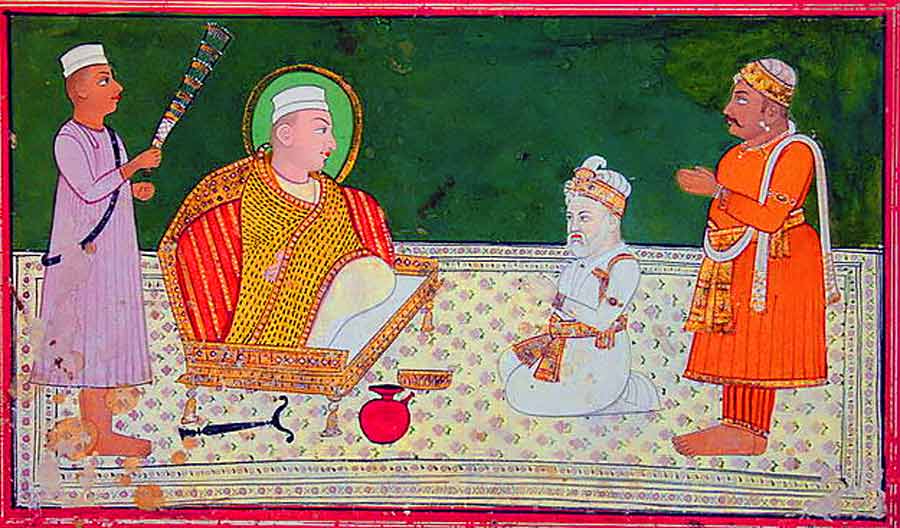
Mughal Emperor Akbar shows deference to Sufi saint Sheikh Salim Chishti, Bikaner, cc late 18th - early 19th century
The Sufi is absent from himself and present with God.
~ Hujwiri
The object of Sufi spiritual teaching can be expressed as: to help refine the individual’s consciousness so that it may reach the Radiances of Truth,
from which one is cut off by ordinary activities of the world.
~ Idries Shah
Introduction
For many people Sufism and Islam are synonymous; in fact Webster’s dictionary defines Sufi: as a Muslim following the principles of a special form of
Islamic mysticism. Yet, the tradition of Sufism pre-exists Islam and is considered by many as the original mysticism; existing since the beginning of time
and available in all religion, cultures and countries. By its followers, this living vibrant inner tradition is considered the core of all religions, and a
succession of living Masters has guarded this Path since the beginning of time.
Understandably there is a strong Sufi current within Islam; as Islam is one of the great monotheisms and Sufism is believed, by its followers, to be at the
heart of all the great religions. Of late, with the world being engaged in a third world war fighting Islamic terrorists bent on Jihad, it is
important to shed some light on this aspect of Islamic teaching and its relevance to Sufi learning and helping humanity reach higher. One must keep in
mind, there are fanatics in every belief system and much of this discord rests in interpretation of specific teachings, and the desire/greed to control
others.
In trying to define Sufism, or who is a Sufi, we run into certain limitations; some of these include trying to put into language a spiritual experience or
define a level of spiritual attainment. Traditional definitions found in dictionaries or books written by non-Sufis are not fully sufficient yet they are a
beginning. For example, a Sufi is someone who follows the Sufi Way and is the end product of study; yet anyone who has been initiated or studies Sufism
does not call them self a Sufi- it is considered improper. From a Sufi perspective, one who follows the Sufi way is considered a seeker. The end product of
this seeking and learning is a Sufi- a completed person; someone who has added a degree of spiritual capacity to their many other capacities. This
spiritually advanced person is very rare, and not limited by common definitions; they exist in both worlds simultaneously and have a variety of functions
which help humanity.
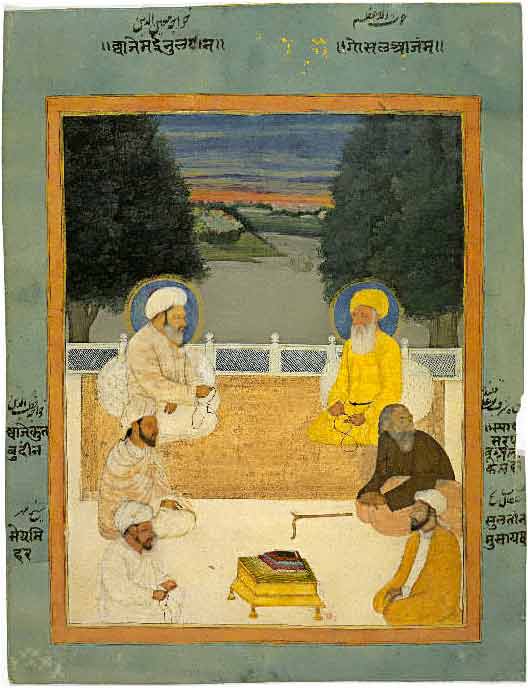
Six Sufi masters, a painting in opaque watercolor and gold, cca 1760
I- What is Sufism?
Traveler:
When friends ask me what I study, and I try to explain, I find it hard to put into words, what is Sufism? Help me understand so I can give a clearer
explanation.
Master:
One of the great teachers offered, ‘long before there was a name (Sufism) there was a reality. Now there is a name without a reality.’ What is meant by
this is that there has always been a way to connect with and experience ultimate Truth; this spiritual path of learning existed long before travelers, in
the late 1800’s, gave this way of learning its present name-Sufism. At the time, local ascetics wore a distinctive woolen (soof) robe and became known for
this. Now this name, or spiritual form, for many followers exists without a corresponding inner reality. Often, today what you see in the world represented
as Sufism is an empty shell of its former self.
This ancient Path of spiritual development is based upon and connection with and experience of the Divine. This connection occurs in daily life doing a
variety of seemingly ordinary activities. It involves study with a teacher and the awakening, through direct contact with Truth, of latent spiritual
capacity; this is done so the traveler can help others. The Truth or universal essence, the spiritual travelers seeks and experiences, is the underlying
energy or fabric of created forms.
The Path existed long before there were religions; this way of learning is at the heart of the great religions; it is the underlying spiritual energy that
gives everything in the universe its form and substance. Inside each of us is an aspect of this wondrous element. Through preparation, practice developing
our inner spiritual awareness and Grace we unite with and serve Ultimate Reality every day.
One of my teachers called this Path- the Superhighway to God. For those who wish to connect with Truth and use their inner spiritual capacity to help
others; this form of learning is available in every town and city.
Sufism is not something talked about or described in written words; it is a universal essence that is experienced and known through inner spiritual
contact. Much like love; no matter how many words you use- the description is not the same as the actual experience. And like love which ebbs and flows,
Sufism changes to fit the learner, time and place.
Traveler:
This helps a little. Sufism is difficult to put into words because it is a spiritual experience and changes with each person. Yet, I have been in love and
know there are different forms of love with many peaks and valleys that are impossible to fully describe; and no matter how pretty a poem or love song, it
is not the experience itself.
Master:
Remember everyone is a spiritual traveler or seeker and in their long journey through this universe, experiences many wondrous things. Countless
experiences go beyond words and cannot be written down- changing with each moment and person. This dimension is one of the elements that make life so
complex and beautiful. If this is too difficult for those who ask about us to grasp, ask them to define love or even life itself. As they ponder all the
possibilities then they will begin to understand.
The Sufis remain a mystery to most people. This is by design and function. As previously indicated, Sufis do not call themselves Sufis. In an attempt to
define them, others have given them this name. Further, it is believed, that under certain conditions, the word ‘Sufi’ helps facilitate a certain desired
state of mentation. For convenience of writing, although inaccurate, I will be using the term Sufi.
Sufis are secretive. In order for them to do their work, they have proliferated information about themselves to the point that it confuses the average
person. Some of this data even appears to be contradictory. Also because Sufis see their function as multi-level, and have a variety of tasks to
accomplish, they do not wish to be distracted by the curious or sensationally minded. Answering questions can be time consuming and unproductive. The
following are some Sufi principles, beliefs and traditions.
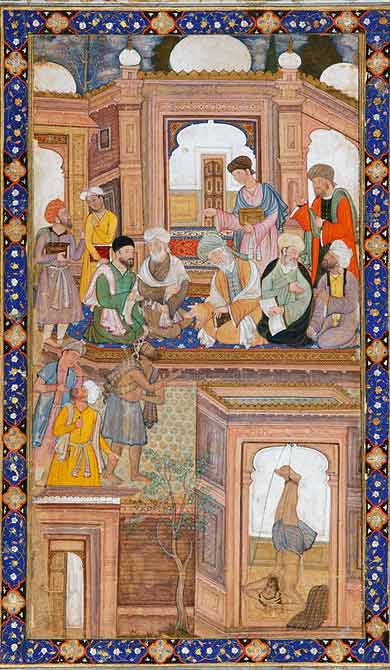
Sufi reunion in the Jami`s Nafahat al-Uns, 1604, Museo Lazaro Galdiano
1) According to Sufi tradition, humanity is evolving to a higher condition. This purposeful evolution is guided by a Plan and includes the awakening of
certain capacities within each person. The guardians of this evolution and Plan have the responsibility to help direct and correct deviations.
2) Humanity originated ‘far beyond the stars’ and will one day return home. While in this realm many possibilities exist. The highest or noblest is
alignment and action with the Truth or Light.
3) The Truth is the underlying unity of the Universe; it is the Mother and Father of us all. The Truth becomes manifest so it might be Known, Loved and
Served.
4) With the awakening of certain capacities, additional abilities appear. Some term these supernormal. They are natural by-products of another state of
consciousness.
5) To the Sufi the most important thing on earth is the protection and correct application of knowledge. This knowledge is acquired, naturally through a
guided course of study.
6) In order for the seeker to be successful, there must be an alignment between the student, the teacher and the Path. It is the Grace of the Path which is
the magical element.
7) Teachers can instruct in any media. In the past, a religious format was used. In America today, it is a scientific/psychological/self-help one. In other
ages, poetry and alchemy were used.
8) There has never been a time or community that has been without the teachers or enlightened ones. They can be of any faith or spiritual background. They
are with us today and are our most precious resource.
9) Because of the disharmony in the world today a corrective must be added. This is the higher or spiritual knowledge. It is a nutrient which helps other
capacities mature and expand. This nutrient is added one person at a time.
10) All paths are sacred and on an inner level united. It is only on an external level they appear different.
11) All aspects of consciousness are important. A balance must be struck between the many selves. The balancing factor is the higher consciousness.
12) The course of study is multi-level and individual. The teacher sets the progress of exercises, readings, experiences, and other learning devices. It is
always dependent on an assessment of the seeker’s condition, and the teacher adds the corrective to create an independent, fully developed individual.
13) The aim of the process is to develop integrated, completed human beings who participate in the world and have the capacity to see things from a
spiritual/holistic perspective. This sight leads to correct action and what some term human excellence.
14) The course of study is a science; it has been called ‘the Science of Man.’ It was perfected thousands of years ago and involves elements of philosophy,
psychology, art, science and many other systems. Some claim that all these systems are outgrowths of this primordial, fundamental knowledge which the Sufi
perceives.
To the uninitiated, some of these claims or statements may seem exaggerated; perhaps something out of science fiction? Yet, the Sufis would be the first to
say, don’t believe us- test these statements yourself.
Now, after this brief over view of the Sufis and some of their beliefs, let us turn our attention to Sufism and Islam.
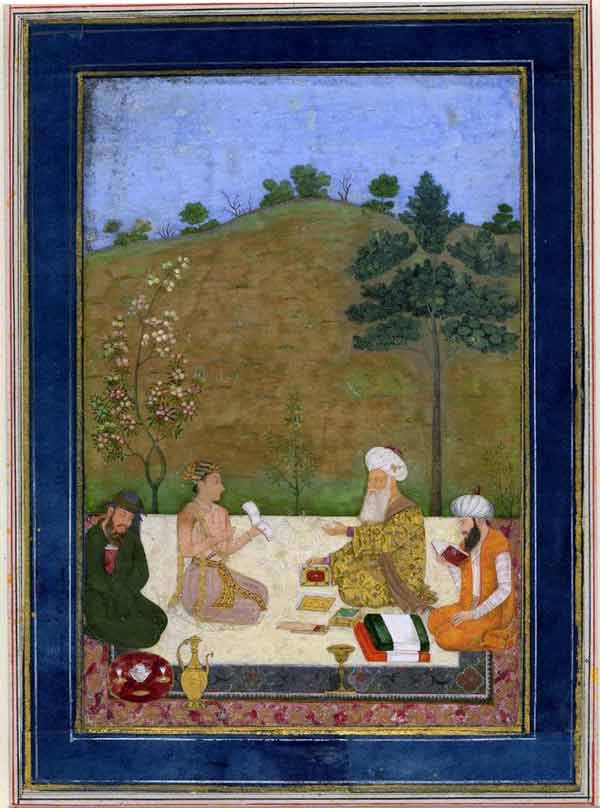
Mughal Prince, Dara Shikuh and three holy men, ascribed to Dal Chand India, Mughal school, c. 1650
II- Sufism & Islam
"
Say ye: 'we believe in God and the revelation given to us and to Abraham, Ismail, Isaac, Jacob, and the Tribes, and that given to Moses and Jesus, and
that given to (all) Prophets from their Lord. We make no difference between one and another of them, and we bow to God.'”
Koran (2:136)
Islam is one of the three great monotheisms and was brought to the desert people of what is now the Middle East by the Great Prophet Mohammed. In his time,
Mohammad was called the unlettered prophet because he could neither read nor write and his messages came in the form of Suras (chapters) of wonderful,
unmatched poetry. These recitations were inspired through the Archangel Gabriel and were a message to all people on how to live and treat each other with
respect and kindness. In every sense, Mohammed was a social reformer and this message called people to follow a higher moral code. At the time female
infanticide, adultery, murder and robbery were common; women were treated as property and travel throughout the land was very dangerous because of thieves
and murderers.
At the heart of any moral teaching is how to improve yourself and become a better person; thereby making the world a better place. Since the beginning,
there have been those who have used religious belief to kill and take. These people have in fact become the enemy of Truth and if the Redeemer were alive
today, the Prophet would be the first to call them out.
Additionally, many people overlook the fact that this Message was sent to a given population during a specific period in history; while it is transcendent,
it is also targeted to time and place. Sufis operate under the requirement that spiritual Messages need constant updating, because people and cultures
across time are different. Hence the tradition of the living Master who updates the Message for each time and place. People forget, Spiritual Messages can
be specific to time/place and transcendent; yes, the container may decay and change, but the inner message remains vibrant.
Sufi Presence Within Islam
According to Sufi Tradition there was an inner teaching that Mohammed gave to his immediate circle of followers. Much like the followers of Jesus, there
was as an esoteric mystical message conveyed and experienced through the spirit and was offered to selected students.
When most people think about the Sufis, they automatically relate to the visible Sufi Orders that have emerged throughout the centuries. These Orders being
tied to Sufi giants like Suhrawardi, Rumi and Naqshband. All of these Orders honor the Prophet Mohammed, follow the teachings of the Koran, and connect
with the inner message offered by Mohammed to his followers. This inner, esoteric mystical stream that must be experienced and is set free by the Sufi
Master, according to Sufi Tradition, has existed since the beginning of time and is to be found within all religions and exists independent of religion.
For example, my first Teacher was not affiliated with any of the Sufi Orders; in Sufi terms, he was called one of the Deposit Sufis. Although from
Pakistan, he spoke excellent English and his message was tied to the Unity of All Religions and the Perennial Philosophy. There were prayers, exercises, a
suggestion to follow the religion of your birth, if you were able, and an overriding inner connection, spiritually to the Absolute. The true Sufi makes use
of religion but is tied to a Reality that exists beyond religion. Working in both worlds, he/she is Master who serves in the Name of Truth.
In relation to our present discussion, 2 key Sufi technical terms require further elaboration; Sufi’s have long held that humanity suffers from ‘ world
sickness’ and The Teaching is the cure to help seekers overcome the pull of the lower self and still their own ‘inner conflict.’
Humanity suffers from ‘world sickness,’ and the teaching provides the cure and helps the traveler see reality. Most people live their entire lives attached
to ideas, possessions and other people. These things to the exclusion of others fill their consciousness. While it is good to be concerned about the things
of the world and involved in making things better for others, there is a point where this investment leads you away from the higher, lasting reality. A
balance must be maintained between the physical and spiritual.
In this endeavor, it is a matter of degree and attitude. With the proper guidance the traveler learns to participate in the world and inwardly limit his
attachment. While the traveler may go to work every day, work hard and try to help others, a part must remain ‘sacred’ and attached to the Light.
Sufis have long held that the inner war- Jihad, the fight between a traveler’s higher and lower nature is a moment by moment struggle. Those who
are somehow able to turn toward their higher self and use, in daily life, their access to spiritual awareness are on the road to enlightenment. This world
is made a better place one person at a time and each person’s life is made up of small moment by moment conflicts, decisions and actions.
Within each of us there is an ancient knowing and awareness that has been covered over by the dust of living in this world. This dust is comprised of
things we are taught, things that we want and things that are necessary to living in the body. This friction between the things we want and need pushes us
forward and gives life both meaning and urgency. Yet those who are able to overcome this pull and somehow elect things which help others have transcended
the physical reality.
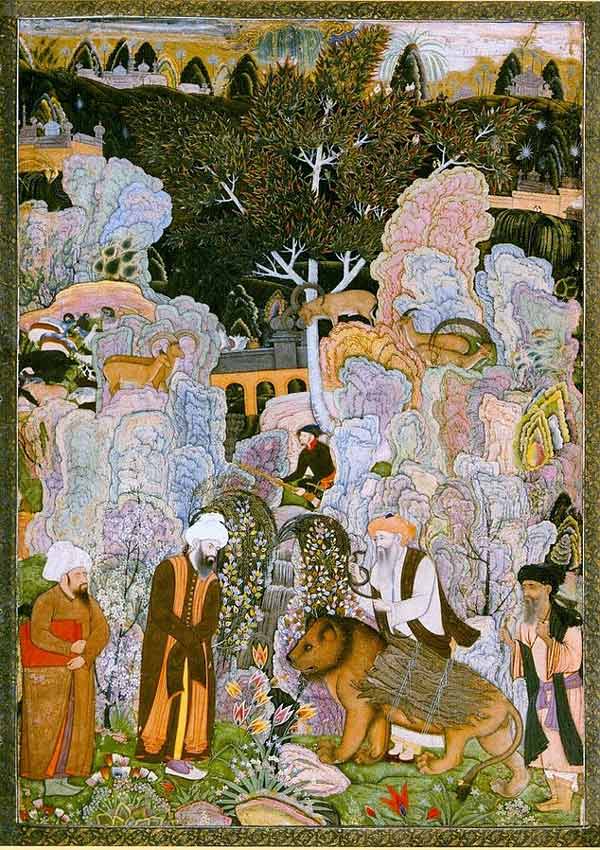
Farrukh Beg. Sufis in a Landscape, ca. 1601-04., Saltykov-Shtshedrin Public Library, St.Petersburg
III- The Lower Self
The Sufis have long held that the source of mankind’s problems, both individually and collectively, has been an exaggerated reliance on the lower self and
over concern (selfish) for one’s own need. According to mystical tradition, each of us has both a higher and lower nature and the spiritual journey, in
part, is to quiet and still the lower self so that the higher self might emerge and become a pronounced part of the seeker’s life.
In many ways, the lower self is necessary to living in the day-to-day world; it tells us when to eat, when to protect ourselves and when to be concerned
for our own best interest. From a mystical view, a little bit is good but too much can be limiting and dangerous to self and others.
Within each of us there is an empty place that we usually seek to fill with all manner of things, habits, obsessions, and addictions; this empty
place or inner longing was created and hard wired in us so that it might one day be filled by the Light of Eternity.
While self-interest is essential to ordinary living, most people due to their fears, become overly greedy and mostly think of them self. They are not
flexible enough to balance their own need with the need of others. The aim of Sufi teaching is to push aside the lower self, for a time, so the Higher Self
might emerge. There is a big difference between pushing aside an aspect of consciousness necessary for survival, and trying to destroy it. One of my
teachers used to say, sometimes like a dog the ego needs a bone and it does no harm to give it one. Because then it is quiet and you can do your work.
Here are 2 quotes about the devious nature of our lower self and how difficult it can be to recognize its influence upon consciousness.
The lower self does not want anyone to receive anything from anybody else, and if it is aware of someone receiving a special boon, it seeks to destroy
it. -Rumi
However much the lower self makes a show of virtue and attempts to conceal vice, the later will be hidden only from the shortsighted and the naïve,
never from those with insight. It is like a hideous old hag who bedecks herself in fancy, dazzling clothes. –Kashani
Conclusions
From a Sufi perspective, the first order of business is to work on oneself. Try to become a better version of yourself. That is the aim of most spiritual
teachings and the goal of the Sufi Path. By making better, more complete people, the world is made better one person at a time. Each spiritual traveler
must recognize who they are; both their weakness and strength so they might at times transcend themselves and help others.